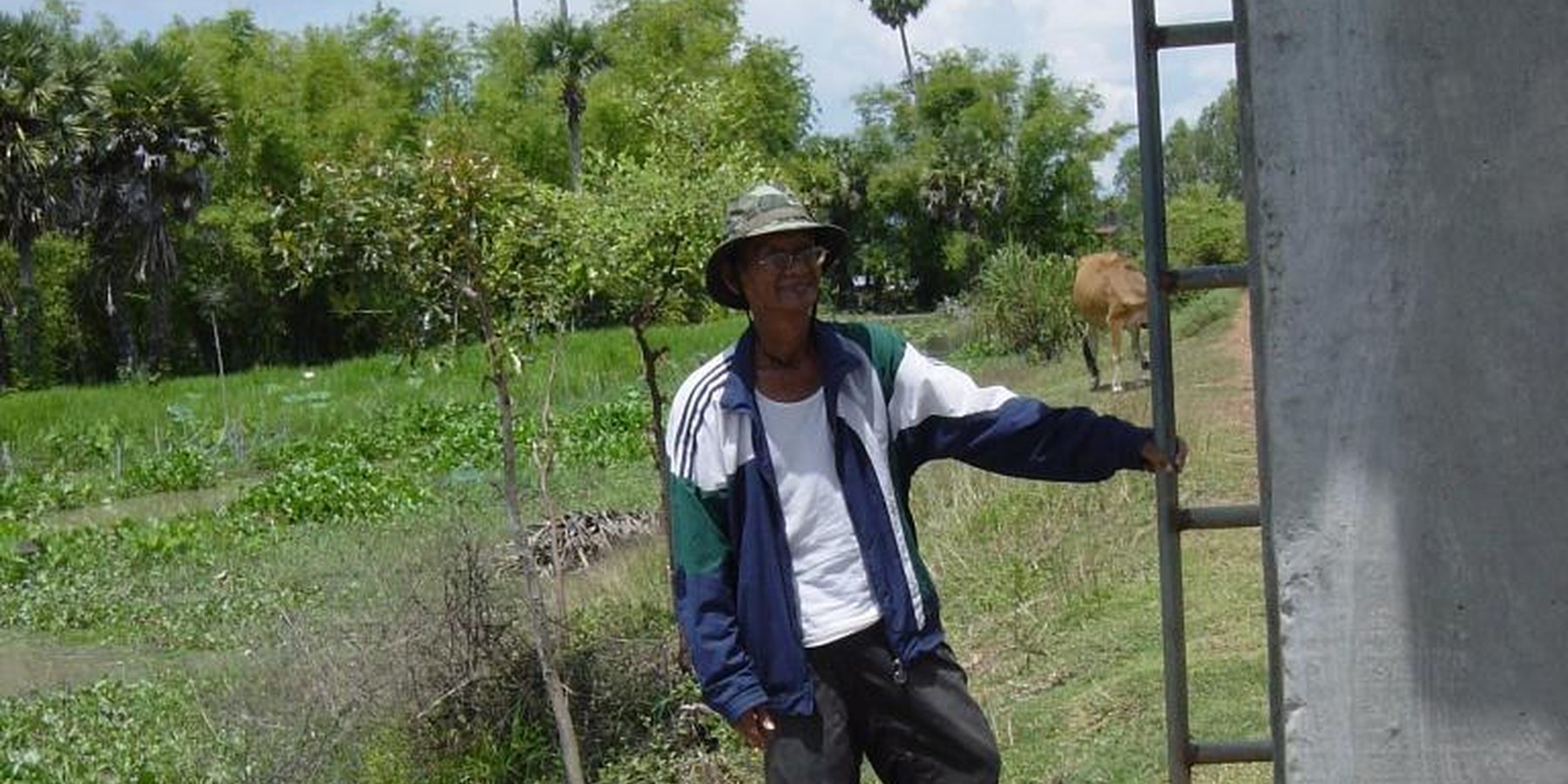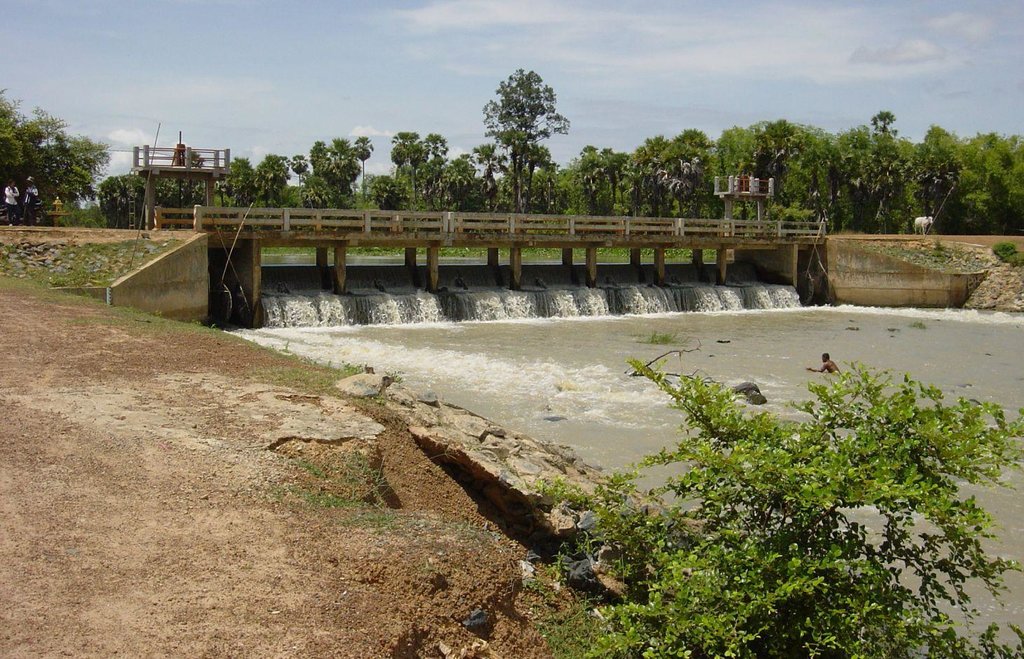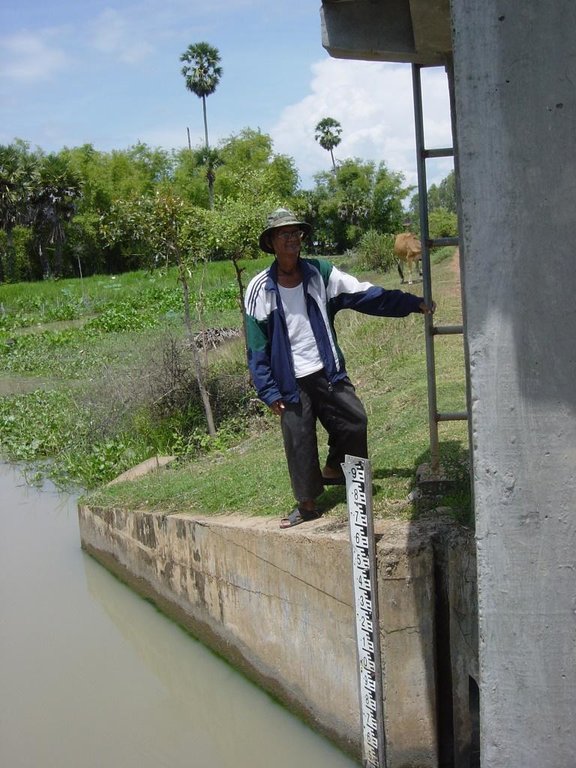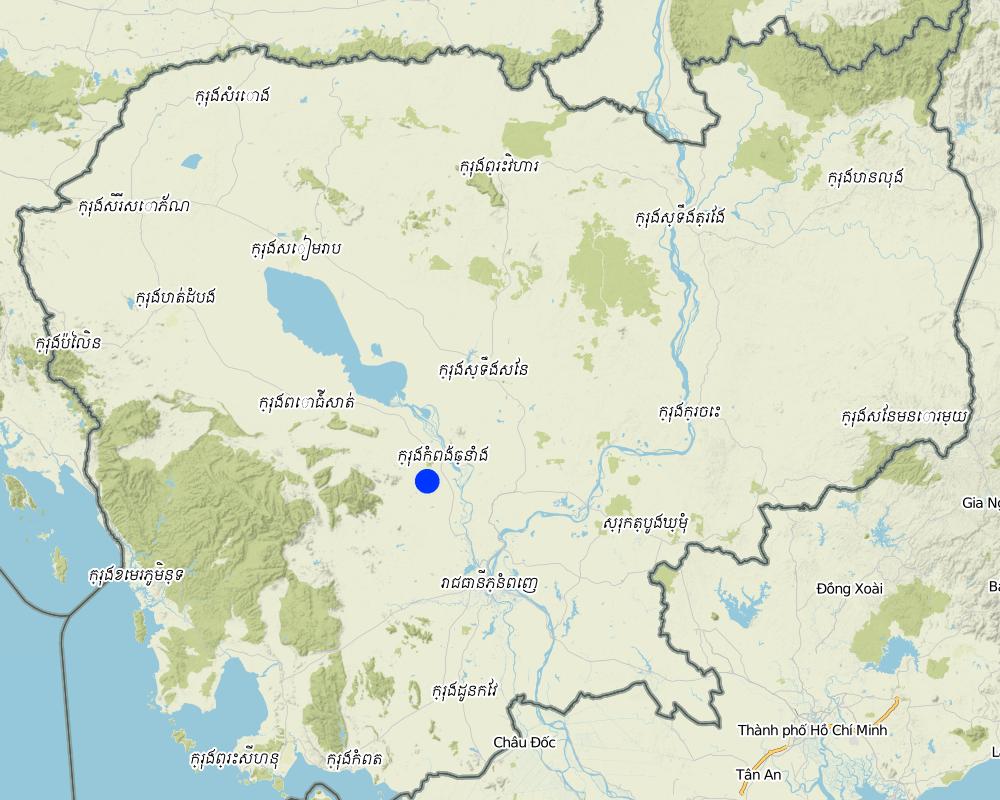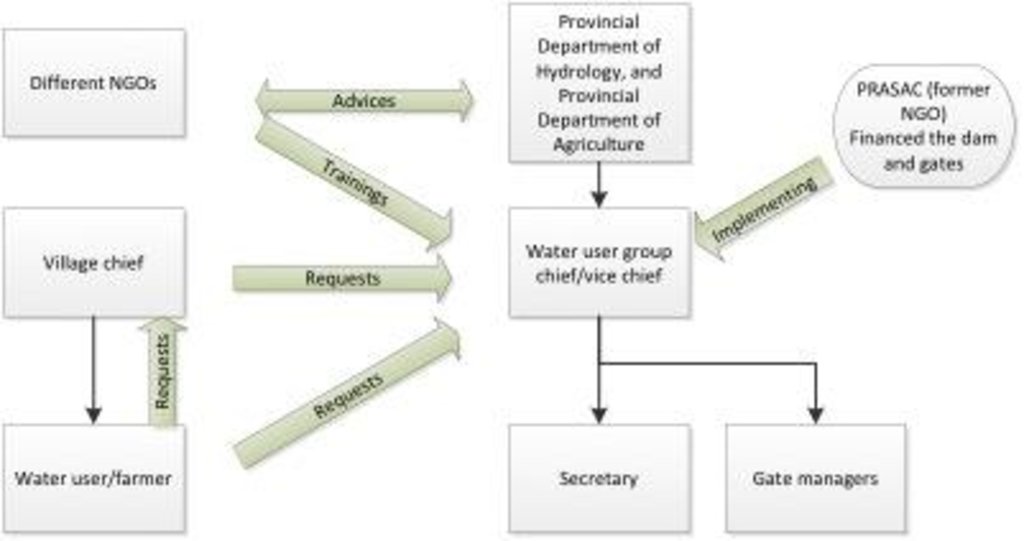Water user group [柬埔寨]
- 创建:
- 更新:
- 编制者: Stefan Graf
- 编辑者: –
- 审查者: David Streiff
ក្រុមប្រើប្រាស់ទឹក (Khmer)
approaches_2595 - 柬埔寨
查看章节
全部展开 全部收起1. 一般信息
1.2 参与方法评估和文件编制的资源人员和机构的联系方式
SLM专业人员:
Pith Khonhel
Local Agriculture Research and Extension Centre LAREC
柬埔寨
SLM专业人员:
Bin Sreytouch
Society for Community Development in Cambodia SOFDEC
SLM专业人员:
Khun Lean Hak
kleanghak@yahoo.com / sofdec@camintel.com
SOFDEC/LAREC
柬埔寨
有助于对方法进行记录/评估的机构名称(如相关)
Society for Community Development in Cambodia (SOFDEC) - 柬埔寨有助于对方法进行记录/评估的机构名称(如相关)
Local Agricultural Research and Extension Centre (LAREC) - 柬埔寨1.3 关于使用通过WOCAT记录的数据的条件
(现场)数据是什么时候汇编的?:
09/09/2014
编制者和关键资源人员接受有关使用通过WOCAT记录数据的条件。:
是
1.4 SLM技术问卷的参考
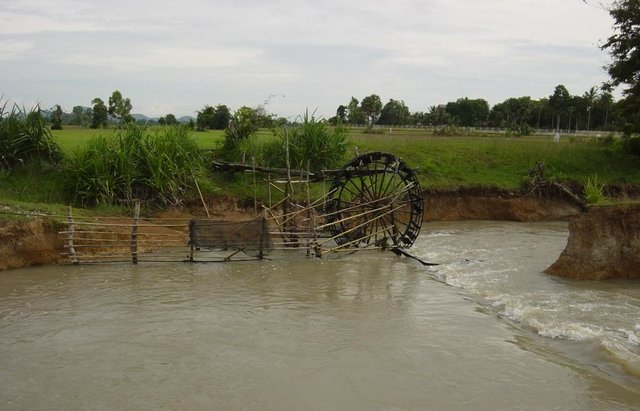
Irrigation of paddy fields using water-pumping wheels (Norias) [柬埔寨]
Norias are water-pumping wheels made of bamboo which are used to irrigate paddy fields in order to increase the yield.
- 编制者: Christoph Kaufmann
2. SLM方法的描述
2.1 该方法的简要说明
A water user group, led by a committee staff, decides about the distribution of the water during the dry season to plant dry season rice.
2.2 该方法的详细说明
该方法的详细说明:
Aims / objectives: During the Pol Pot regime, a dam was built to catch and store water from a temporary stream to irrigate rice during the dry season. The dam degraded over time, therefore it was repaired by a NGO to provide water for the cultivation of dry season rice. To manage it, a water user group was formed. The aim of this water user group is to have a fair distribution of the water hold by the dam among the farmers located downstream. The water user group is led by an elected committee staff of 5 members, who are the direct contact persons for the individual farmers and village chiefs, as well as for the provincial department of hydrology.
Methods: A former local NGO, PRASAC (now a microfinance institute), which repaired the dam and gates, organised a meeting with the three concerned villages to elect a committee responsible for the management of the water. The committee, consisting of a chief, a vice-chief, a secretary and an accounting, and two managers of the gates (each responsible for one gate) is responsible for the fair distribution of the water. The chief is the contact person for the village chiefs or the farmers themselves, who can request water. He is the contact person for the provincial department of hydrology as well.
Stages of implementation: The water user group was elected in 2002, when the dam was fixed. A short training was given to the committee which was then left on its own for the management. After tensions that occurred between farmers, the committee asked for advice in the provincial department of hydrology, which was passed off to CDRI (Cambodia Development Resource Institute), a local NGO. The CDRI conducted meetings and acted as a mediator, since then no tensions occurred anymore between water users as they introduced weekly schedules.
Role of stakeholders: The chief and vice chief are responsible for the distribution of the water. The two gate managers are controlling the gates.
2.3 该方法的照片
2.5 采用该方法的国家/地区/地点
国家:
柬埔寨
区域/州/省:
Kampong Chhnang
有关地点的进一步说明:
Toeuk Phos
注释:
A bit more than 100 ha are irrigated under this approach.
Map
×2.6 该方法的开始和终止日期
注明开始年份:
2002
终止年份(若不再采用该方法):
2003
2.7 方法的类型
- 基于项目/方案
2.8 该方法的主要目的/目标
The Approach focused on SLM only
A fair distribution of water among the farmers, to produce rice during the dry season as well.
The SLM Approach addressed the following problems: The approach was designed to avoid conflicts on the use of water resources, and to allow rice production during the dry season.
2.9 推动或妨碍实施本办法所适用的技术的条件
财务资源和服务的可用性/可得性
- 阻碍
The staff works on a voluntary basis.
Treatment through the SLM Approach: The gate managers catch fish at the gates while releasing water which provides an income. The chief records the water levels behind the dam for the provincial department of hydrology, which provides an income to him.
法律框架(土地使用权、土地和水使用权)
- 阻碍
Conflicts between farmers about water use. The lower villages did not get enough water.
Treatment through the SLM Approach: A NGO, CDRI, acted as a mediator in the conflict. Since then no more tensions occurred as they introduced weekly schedules.
The existing land ownership, land use rights / water rights hindered a little the approach implementation Before there was open access to water, but no water was available since the dam was broken. Now there is water, but it is regulated.
3. 相关利益相关者的参与和角色
3.1 该方法涉及的利益相关者及其职责
- 当地土地使用者/当地社区
Villagers and village chiefs
The operation of the water gates needs a strong physical condition. The literacy of women is lower than the one of men. Only male staff.
Poor people were also involved, and use the water.
- SLM专家/农业顾问
- NGO
PRASAC implemented the water user group.
- 国家政府(规划者、决策者)
Provincial department of hydrology
3.2 当地土地使用者/当地社区参与该方法的不同阶段
| 当地土地使用者/当地社区的参与 | 指定参与人员并描述活动 | |
|---|---|---|
| 启动/动机 | 无 | |
| 计划 | 无 | |
| 实施 | 被动 | The committee was elected, and acts until today. |
| 监测/评估 | 无 | |
| Research | 无 |
3.3 流程图(如可用)
具体说明:
Organogram of the different stakeholders in the water user group in Toeuk Phos.
作者:
Stefan Graf (Centre for Development and Environment)
3.4 有关SLM技术选择的决策
具体说明谁有权决定选择要实施的技术:
- 仅限SLM专家
解释:
The former NGO, PRASAC, fixed the dam that was constructed during the Pol Pot regime. The farmers had to be persuaded to plant dry season rice.
Decisions on the method of implementing the SLM Technology were made by by SLM specialists alone (top-down). The NGO decided that the water user group should be managed that way, organised an election and the same staff works since then.
4. 技术支持、能力建设和知识管理
4.1 能力建设/培训
是否为土地使用者/其他利益相关者提供培训?:
是
明确受训人员:
- 土地使用者
- 现场工作人员/顾问
培训形式:
- 在职
- 示范区域
涵盖的主题:
Growing of dry season rice. The Provincial Dept. of Agriculture rented 100 ha and planted dry season rice. Since then the farmers plant it by themselves.
The staff was trained to work alone managing the water gates.
4.2 咨询服务
土地使用者有权使用咨询服务吗?:
是
指明是否提供了咨询服务:
- 在固定中心
说明/注释:
In case the chief is confronted with a problem, he approaches the Provincial Department of Agriculture. The chief is then either redirected to a NGO or gets help by the Provincial Department of Agriculture.
Advisory service is inadequate to ensure the continuation of land conservation activities; The committee staff provides the water for free, the maintenance costs have to be financed by the provincial dept. of hydrology. PRASAC provided a financial reserve for the maintenance somewhere in the government, but neither the water user group chief nor the secretary/accountant know where this account is.
4.3 机构强化(组织发展)
是否通过这种方法建立或加强了机构?:
- 否
4.4 监测和评估
监测和评估是该方法的一部分吗?:
是
注释:
Bio-physical aspects were regular monitored by project staff through measurements; indicators: Water level is monitored daily by committee chief, data reported to provincial dept. of hydrology.
There were few changes in the Approach as a result of monitoring and evaluation: Weekly schedules were established to avoid conflicts between villages. CDRI was working as a mediator.
There were no changes in the Technology as a result of monitoring and evaluation
4.5 研究
研究是该方法的一部分吗?
否
5. 融资和外部物质支持
5.1 该方法中SLM组成部分的年度预算
注释(例如主要的资助来源/主要捐助者):
Approach costs were met by the following donors: national non-government (PRASAC): 100.0%; local community / land user(s) (Staff consists of volunteers )
5.2 为土地使用者提供财政/物质支援
土地使用者是否获得实施该技术的财政/物质支持?:
否
5.3 对特定投入的补贴(包括劳动力)
- 基建
| 具体说明哪些投入得到了补贴 | 程度如何 | 对补贴做出具体说明 |
|---|---|---|
| Dam and gates | 充分融资 | |
如果土地使用者的劳动力是一项重要的投入,那么是不是:
- 自愿
注释:
the water user group staff works for free.
5.4 信用
是否根据SLM活动的方法给予信用值?:
否
6. 影响分析和结论性陈述
6.1 方法的影响
该方法是否帮助土地使用者实施和维护SLM技术?:
- 否
- 是,很少
- 是,中等
- 是,支持力度很大
They are able to produce food during the whole year, with up to 3 rice harvests a year on the same fields.
该方法是否有助于社会和经济弱势群体?:
- 否
- 是,很少
- 是,中等
- 是,支持力度很大
Landless farmers have more work, as 3 rice harvests are produced per year.
该方法是否改善了阻碍SLM技术实施的土地使用权/用户权问题?:
- 否
- 是,很少
- 是,中等
- 是,支持力度很大
According to the committee chief, no more tensions occur now.
Did other land users / projects adopt the Approach?
- 否
- 是,很少
- 是,中等
- 是,支持力度很大
A fourth village joined the water user group.
Did the Approach lead to improved livelihoods / human well-being?
- 否
- 是,很少
- 是,中等
- 是,支持力度很大
The technology (the dam with gates) helped. But it would not work without the approach. It improved the food production, thus food security, and the livelihoods of the farmers.
Did the Approach help to alleviate poverty?
- 否
- 是,很少
- 是,中等
- 是,支持力度很大
It helped to alleviate poverty among the farmers owning land in the irrigated areas as they can produce more.
6.2 土地使用者实施SLM的主要动机
- 增加生产
Three harvests instead of only one.
- well-being and livelihoods improvement
Three harvests instead of only one.
6.3 方法活动的可持续性
土地使用者能否维持通过该方法实施的措施(无外部支持的情况下)?:
- 不确定
若否或不确定,请具体说明并予以注释:
It is unclear what would happen if the dam needs maintenance but the provincial dept. of hydrology would not be willing to pay the maintenance costs.
6.4 该方法的长处/优点
| 土地使用者眼中的长处/优势/机会 |
|---|
|
Improved livelihoods, three times more rice production and water vegetables as well as fish during the whole year. |
| No pumps are needed. |
| Farmers help each other with the water. (How to sustain/ enhance this strength: Regular meetings. ) |
6.5 该方法的弱点/缺点以及克服它们的方法
| 土地使用者认为的弱点/缺点/风险 | 如何克服它们? |
|---|---|
| There is no money for maintenance activities. | |
| Nobody wants to work as committee staff as they don’t get any salary for this work. |
| 编制者或其他关键资源人员认为的弱点/缺点/风险 | 如何克服它们? |
|---|---|
|
No regular elections, nor bottom up improvements. Everything comes from outside. |
7. 参考和链接
7.1 方法/信息来源
- 实地考察、实地调查
- 与土地使用者的访谈
链接和模块
全部展开 全部收起链接

Irrigation of paddy fields using water-pumping wheels (Norias) [柬埔寨]
Norias are water-pumping wheels made of bamboo which are used to irrigate paddy fields in order to increase the yield.
- 编制者: Christoph Kaufmann
模块
无模块


